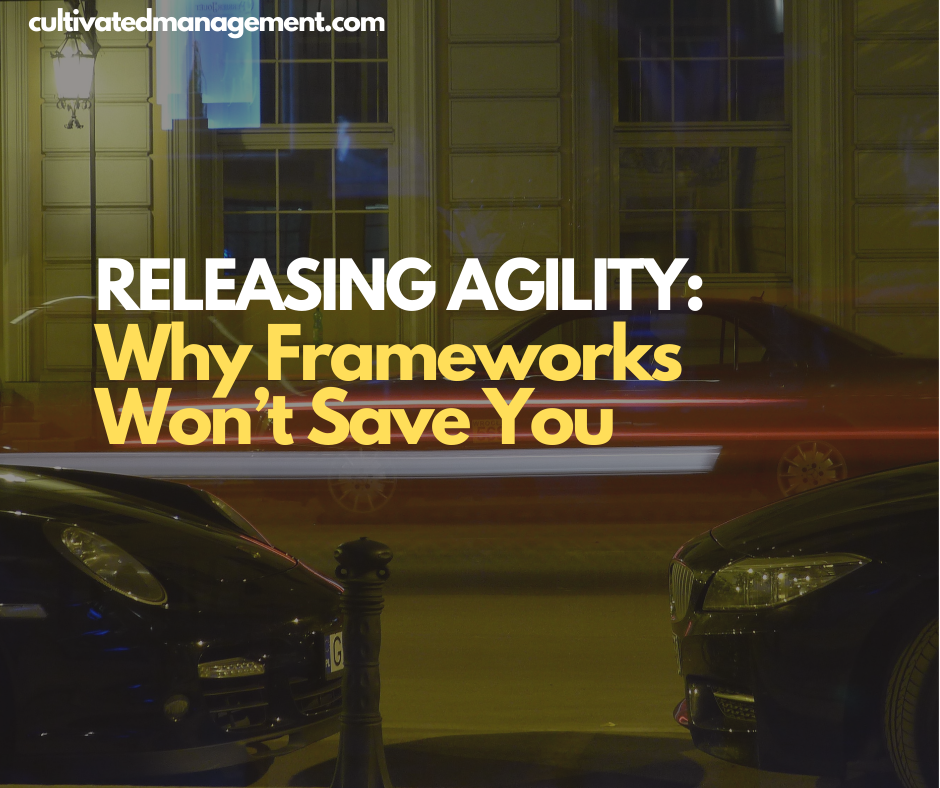
A CIO once leaned across the table, shook her head, and said:
“We’ve spent £20 million on agile training, frameworks, tooling — the whole circus. And do you know what? We’re no more agile than before. Honestly, I think we’ve gone backwards.”
Her tone wasn’t angry. It was weary. The kind of tired that comes from fighting the same battles over and over.
That stuck with me.
Because she wasn’t wrong.
Agility isn’t installed. It isn’t bought. It isn’t rolled out in neat, branded playbooks. It isn't forced. It isn't mandated.
Agility is released.
Read on for more, or check out the video:
When I Got It Wrong
I wasn’t immune. I used to think if I just put the right framework in place, the right ceremonies, the right dashboards, the magic would happen.
I tried it in HR. We went all-in: stand-ups, boards, backlogs. We expected results in weeks. What actually happened? Six painful months of friction, awkwardness, and frustration.
Until something shifted.
One day, it clicked. The framework wasn’t the answer. The team was. Their ideas, their energy, their commitment - and most importantly - overcoming problems that were on the path to our goals and vision.
They started to shape the work in a way that fit them, not the textbook. And it worked.
That’s when I realised: agility is a management problem, not a framework problem.
And when I shared that thought with her later, she just nodded:
“Exactly. We were never short on smart people. We were short on leaders willing to change how they managed.”
Sketching the Essence
I kept asking myself: if frameworks aren’t it, then what is?
So I sketched. Over and over. Diagrams, arrows, circles. Pages of scribbles.
And slowly, the picture sharpened: agility wasn’t something to do — it was something to unleash.
That’s why I call my model Releasing Agility.
When I explained it to her, she smiled and said:
“That’s it. We had agility in the building all along. We just buried it under processes and jargon.”
What Releasing Agility Means
It’s simple:
- Release — to set free, to unlock what’s already there.
- Agility — adaptability and speed in moving towards business goals.
Put them together, and it’s not about installing practices from the outside. It’s about creating the conditions where agility can emerge from the inside - towards a future vision (or painted picture) that is compelling, exciting and motivating.
The CIO’s Lessons
That £20m conversation with her taught me more than any book or training course. Here’s what I distilled from it — and what I tell every leader now:
- Frameworks won’t save you. At best, they’re a starting point. At worst, they’re a distraction.
- Agility isn’t an end goal. It’s a way of working, adapting, and learning — always evolving - it's a never ending journey.
- There’s no silver bullet. No framework, tool, or consultant has the answer in a box.
- This is a management problem. If leaders don’t change, nothing changes.
- You already have most of what you need. Agility comes from people, not products.
- It’s about communication. Clarity, alignment, storytelling — not jargon or post-its.
- It’s about behaviours. Not ceremonies. Not tools. Behaviours.
Or, as she put it to me later:
“We didn’t need another consultant selling us a shiny framework. We needed managers who could listen, adapt, overcome problems and actually lead.”
The Five Steps to Releasing Agility
When I boiled it down, I saw the same five steps repeating across every team, every transformation, every success.
1. Paint a Picture of the Future
Where are we going? Why does it matter? People rally behind a story, not a slide deck.
As she told me: “If your people can’t tell the story of where you’re heading in their own words, you haven’t done your job as a leader.”
2. Understand Today & Build a Strategy
What is our current reality? What’s working, what isn’t? What problems do we need to solve? From there, build the bridge — your strategy.
3. Build the Right Team
Do you have the people, culture, and behaviours to get there? If not, what needs to be done about it.
4. Shape the Routines
Processes and habits make or break you. Build routines that serve the work, not the other way round. This is where the agile specialists had started - but there is little point if you have the wrong people, overcoming the wrong problems and heading in the wrong direction.
5. Keep Learning
Agility without learning is just busyness. Learning keeps you moving in the right direction.
Her final word on this was simple: “If your teams aren’t learning faster than the market is changing, you’re already behind.”
So, What Does This Mean?
When that CIO told me about her £20m disaster, she didn’t need another framework. She needed clarity, alignment, and better management. She needed to release the agility that was already locked up in her teams.
And that’s the hard truth:
- Agility isn’t something you buy.
- It isn’t a framework.
- It isn’t a silver bullet.
It’s leadership, behaviours, clarity, and the never ending solving of problems that are on your path.
Everything else is just packaging.
👉 That’s why I built Releasing Agility. Not as another framework, but as a lens. A way of seeing agility for what it really is: already there — waiting to be unlocked.
If you'd like my help to coach managers and leaders, or as a consultant to help you spot the levers of change to Release Agility, please check out my services.
